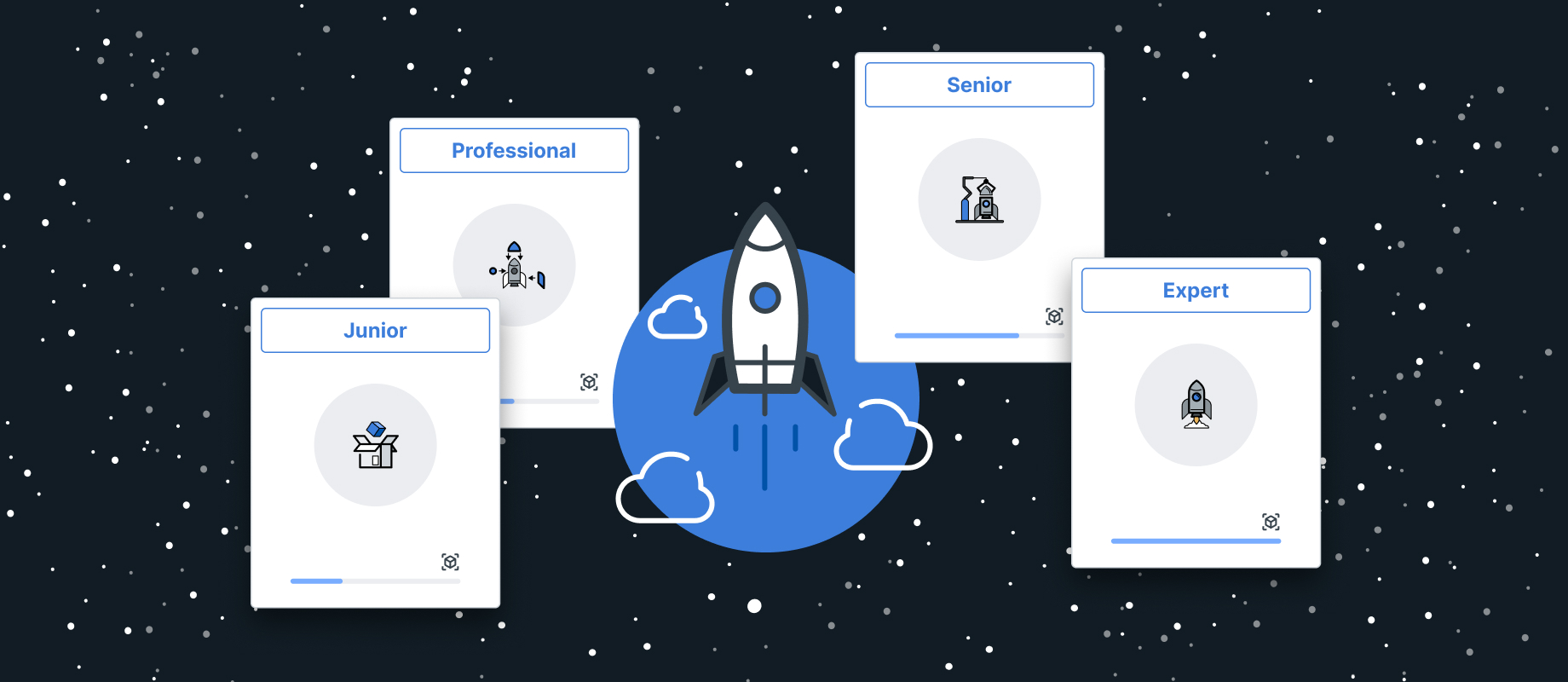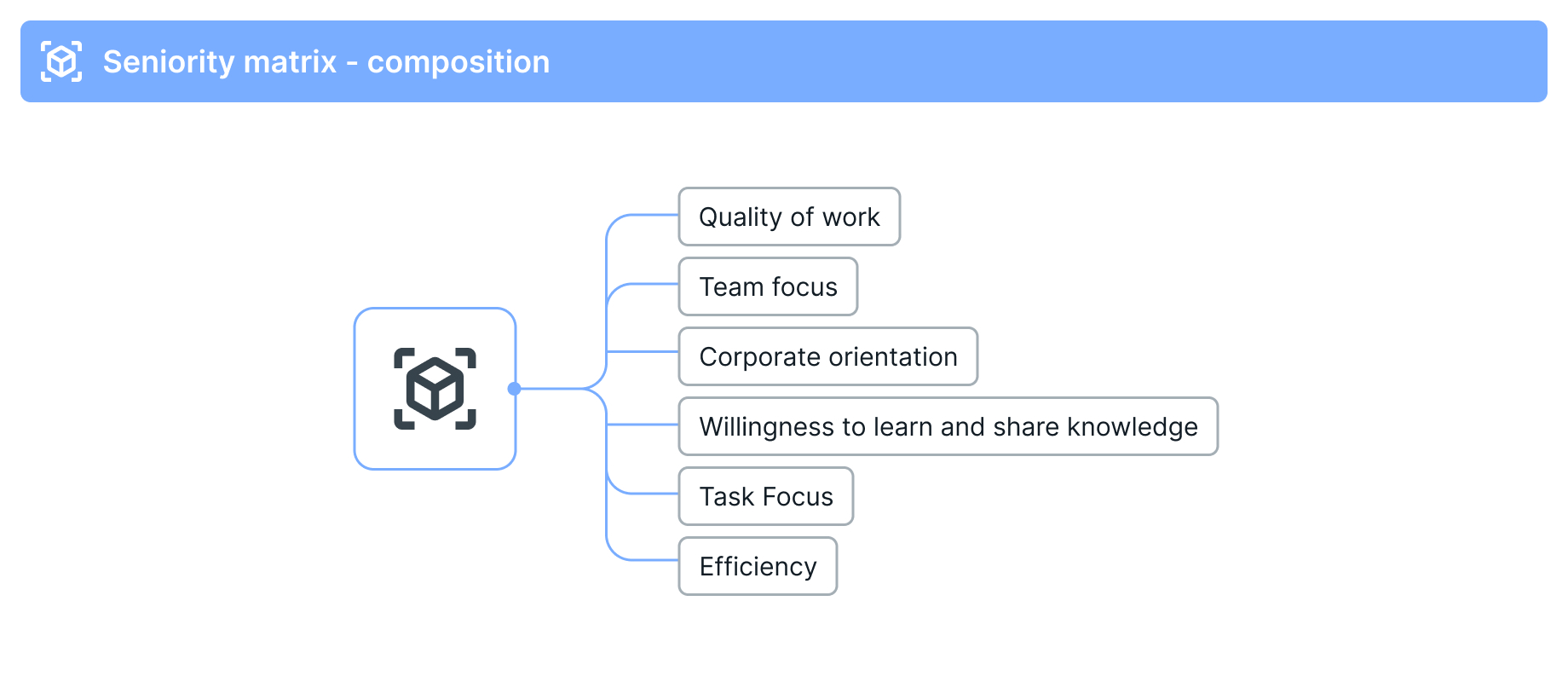
We see ourselves as an attractive employer for talented team players. Therefore, it was time to take a closer look at the opportunities and perspectives we offer our employees to develop and fulfil themselves in the long term at IT Sonix. For this purpose, we dealt with fundamental questions of personnel and organisational development in a project lasting several months.
The results are descriptions for all professional roles that exist in our company and - brand new - a seniority matrix. This provides orientation for all employees, which is of huge importance for our entrepreneurial success as well as our corporate culture. But let's take it one step at a time.
Realisation
At the beginning, we designed a standard template for the description of all our professional roles. In addition to the concrete tasks, it was important to us to make it clear why a certain role exists at all and what concrete contribution it makes to the success of the company. Both should provide orientation for current and future role owner as to what is expected of them and what they can look forward to in the role. Examples of these roles include Agile Coach, Data Scientist, Usability Engineer and of course those that most of our employees fill: Software Developer.
In addition, it was important for us to make transparent what is required for a successful performance of the role. So we sat down and wrote down for each of these professional roles what expertise is needed for it and also what personal-social and methodological competences are usually needed to be able to perform the role successfully. It is helpful that current and future role holders know exactly what to expect when they take on the role. This will help them to focus on their personal and professional development to be more effective and successful in their role.
The role descriptions each have space on one A4 page and are thus comprehensible and compact. They will be helpful to us as a company in many places in the future. For example, during introductory interviews with new applicants. On the basis of the descriptions, we will be able to compare mutual wishes and expectations even better than before. In the future, we will also be able to determine more easily whether a particular role is suitable for the person in question or whether we should focus more on other roles. These role descriptions will also actively support us in onboarding or staff development. They will make it even easier for us to design orientation or development plans that are more precisely tailored to the individual requirements and wishes of all those involved.
The roles are assigned to our three major divisions:
- Software Development & Data Science
- Consulting & Sales
- Central Services (this includes the classic support teams Office Management, Accounting and Human Resources)
In total, we have more than 20 professional roles at IT Sonix. In addition, there are roles that entail greater organisational responsibility, e.g. team or project management.
If necessary, we also check whether there is potential for the introduction of additional roles due to new corporate requirements. If this is the case, this also results in additional development prospects for our employees. The aim of these activities is not only to implement customer requirements, but also to offer diverse and attractive perspectives for professional careers at IT Sonix.
SENIORITY LEVELS
So much for roles and role descriptions. This is the basis for our next building block: the seniority levels.
These describe different levels of seniority or experience that professional role holders bring with them or have already achieved. We have a total of four of these levels. Starting with Junior, it goes through Professional and Senior to Expert. The purpose of these levels is to make it easier for all employees themselves, as well as those with whom they work closely, to give feedback on where employees are in their development. Of course, things like seniority and experience cannot be calculated exactly. However, with the help of the levels we have developed, a fair classification becomes much easier and more comprehensible.
The individual as well as corporate added value of our level model is that we can make it transparent what it takes to reach a certain level. This gives our employees a better idea of how they are perceived and assessed and, above all, what they should focus on in their development. In future, we will discuss this more intensively in the regular staff meetings and, based on this, draw up individual career development plans and agree on concrete support measures.
INDICATORS
But that is not all. Long-term professional and personal development requires more than just knowing what a role is about and the levels of experience involved. And this brings us to the third building block of our development and career paths: the indicators. They are used to determine which level employees are currently at and what the requirements are for our Expert level, for example.
The main focus here is on those factors that are most important for both the entrepreneurial success and the corporate culture of IT Sonix. One is the quality of work. Our customers appreciate the high quality of our products and services. This is also the reason why they build a confidential business relationship with us over many years. Therefore, it is central to our development and career model that with increasing experience and seniority, the quality of work of the role holders also steadily increases.
So how is high or very high quality of work defined? We base this on the employees' own assessment as well as on feedback from those who work most closely with them. This is how we ensure that the most balanced and diverse perspectives possible come together for the definition.
On the other hand, a pronounced team orientation is just as important to us. After all, we are committed to being an attractive employer for talented team players. From our point of view, sustainable success is only possible together in a team and therefore this aspect is of great relevance to us. For example, in addition to personal advancement, we always have the well-being of the entire team in mind. Sometimes it can make more sense to put one's own point of view aside if this helps to strengthen the cohesion and cooperation in the team. At the same time, this means for us to be open to feedback and to take away from it those aspects that can help one's own development.
For us, team orientation is also strongly linked to the subject of knowledge transfer. It is important to us that those employees with the most knowledge and experience pass it on to those with less experience and support them in their development. We believe that we can only be successful as a company in the long term by supporting each other and benefiting from each other through a mutual transfer of knowledge.
SENIORITY MATRIX
 These and other indicators are included in our seniority matrix. In this matrix, we have defined examples for each indicator and how it can be expressed at the respective level. Again, this is not exact mathematics, but with the help of the examples we can make it easier for our staff to assess themselves and give feedback to others. On this basis, we can also better discuss development perspectives in the regular staff meetings and design subsequent development plans.
These and other indicators are included in our seniority matrix. In this matrix, we have defined examples for each indicator and how it can be expressed at the respective level. Again, this is not exact mathematics, but with the help of the examples we can make it easier for our staff to assess themselves and give feedback to others. On this basis, we can also better discuss development perspectives in the regular staff meetings and design subsequent development plans.
Conclusion
So what do all these things pay into now? The roles, the levels, the seniority matrix? Here is a summary of the most important points:
- We create transparency about which indicators we consider to be essential for our long-term corporate success
- We make the assessment of employees' performance and actions more objective and comparable and hope to increase the acceptance of feedback
- We provide clear guidance on our development and career prospects and the basis on which we determine gradings
- We can plan development plans and training measures more individually and implement them in a more targeted way
Finally, we would like to point out that all these elements, which for us are part of the development and career paths at IT Sonix, were developed together. Together means that we sat together in workshops with employees from different teams, developed and gave feedback. This allowed us to incorporate many helpful suggestions, especially from those who will also be working with these tools the most. We are looking forward to seeing how they help us become an even more attractive employer for talented team players in the future.